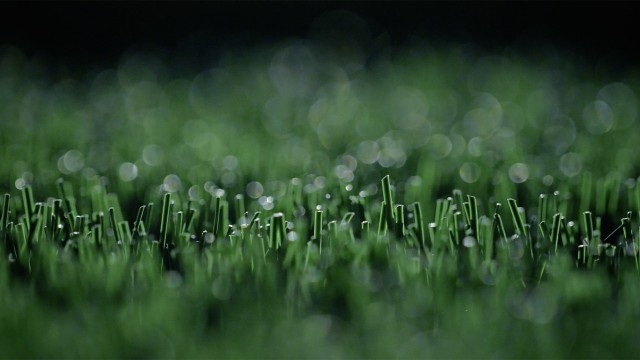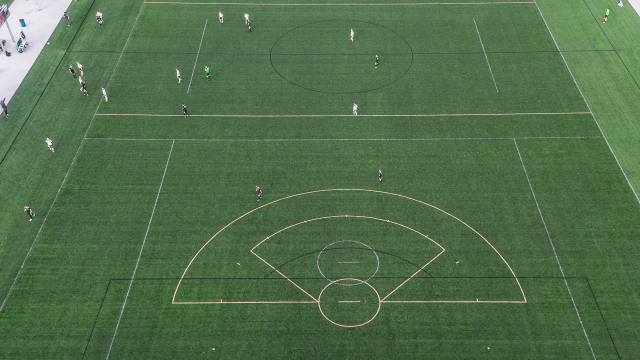How much does artificial turf / synthetic grass field cost?
This is one of the first questions most potential clients have. How much does FieldTurf cost? Prices vary from region to region and from product to product. It also depends on the sports your field turf surface will be used for. Most of our artificial turf installations are for football, soccer, baseball, lacrosse and field hockey.
Here is a general estimate of the initial cost of an synthetic turf football field. It is broken down into two parts:
Drainage base
The drainage base consists of compacted stone materials found beneath the turf carpet, providing a level surface which allows precipitation to trickle through it before reaching the drainage system.
For a typical full-sized football or soccer turf field, approximately $4 per square foot should be budgeted for the drainage base.
Drainage bases can have a life expectancy of 20-30 years (the life of 2-3 turf fields).
Turf
The turf panels (carpet) are laid on top of the drainage base and the infill materials are layered into the carpet to provide footing to the athlete and protection from the stone base below.
For typical, full-sized football or soccer turf fields, a conservative price of $5.00 per square foot should be budgeted. Football and soccer fields are approximately 80,000 square feet.
For a detailed breakdown of the costs and return on investment, view our Cost Analysis page.
How long does a turf field last?
After asking about the price of an artificial turf surface, potential owners often ask "How many years will a FieldTurf sports field last?"
The industry standard is to provide an eight (8) year warranty on all synthetic turf materials. However, due to FieldTurf’s unwavering dedication to quality, we’re able to showcase the largest amount of fields that have lasted beyond their warranty.
We have more fields that have lasted 10, 11, 12 and even 13 years than all of our competitors combined! Learn more about the Durability of our surfaces.
Why choose synthetic turf over natural grass?
The costly and intricate maintenance of natural grass makes it difficult for many institutions and municipalities to keep their fields in a playable condition which is safe enough for its players.
A FieldTurf field provides a near-perfect surface for years, and with limited maintenance and no customer expertise needed.
Artificial turf represents a higher initial capital cost than natural grass, but this is often recuperated through extended hours of use of the fields (no down time, no recovery time, and playing longer into different seasons), lowered maintenance costs (no watering, no mowing, no chemicals), and revenue generation (renting the field).
Read more on the detailed breakdown of costs of a turf field and the potential revenue generation in our Cost Analysis page.
What should I look for in choosing an artificial turf system provider?
Building a quality artificial turf field is complex and demands a high level of experience and quality control. Far too many companies enter the industry, hiring suppliers for fiber manufacturing, tufting, coating and installation.
You will want a company that has full control on all aspects of your field. From manufacturing the turf to installing the system. Furthermore, you will want a company capable of producing your turf fields with proven materials and with the highest quality control measures through ISO certifications.
Finally, you will especially want a company with exclusive, experienced installation crews, installing turf systems which are proven in all seasons and all regions of the world.
For more information on why FieldTurf should be your synthetic turf manufacturer of choice, visit the Why FieldTurf page.
Where can I see FieldTurf installed?
FieldTurf is the choice of thousands of clients around the world. With over 6500 installations in the USA and 25,000 worldwide, you will find FieldTurf football fields, soccer fields and baseball fields in all 50 states.
To view some of our highlight construction projects, see our Featured Installations or contact your local representative for a comprehensive list in your area.
What maintenance needs to be performed on an artificial turf field
A synthetic turf field is far less maintenance than a natural grass field, however, this does not mean that it should go without care. Brushing, aerating, raking and sweeping the surface should all be part of the standard process of maintaining your artificial turf field.
For more information, download the Guidelines PDF.
What is the difference between FieldTurf and the traditional non-infilled carpet systems?
FieldTurf invented the newest generation of artificial turf fields, which are now far more commonly known. In 1997, FieldTurf introduced infilled, long pile artificial turf which contained polyethylene (plastic) fibers, with sand and rubber particles between these fibers acting as artificial earth, giving the athletes shock absorption and natural footing.
This replaced the non-infilled carpet systems, which consisted of abrasive nylon turf fibers and no infill.
What teams are playing on FieldTurf?
The majority of our 6500 artificial grass systems have been installed for high schools, colleges and municipalities around North America.
Our quality has also been coveted by the highest profile sports teams. Here is a sample of the NFL, MLS, and NCAA teams playing on FieldTurf.
Professional Teams Playing on FieldTurf
- New England Patriots (NFL)
- Seattle Seahawks (NFL)
- Atlanta Falcons (NFL)
- Detroit Lions (NFL)
- Atlanta United (MLS)
- Seattle Sounders (MLS)
- New England Revolution (MLS)
- Portland Timbers (MLS)
- Vancouver Whitecaps (MLS)
NCAA Football Teams Playing on FieldTurf
- Texas Longhorns
- Oregon Ducks
- Arizona Wildcats
- Michigan Wolverines
- Nebraska Huskers
- Minnesota Golden Gophers
- And hundreds more
NCAA Baseball Teams Playing on FieldTurf
- Oregon State Beavers
- Oregon Ducks
- Texas Tech Red Raiders
- Tennessee Volunteers
- Southern Miss Golden Eagles
- Air Force Falcons
- And hundreds more
For more information on some of our highlight fields, visit our Featured Projects section
What is involved in the installation process?
Installing an artificial turf field is a highly complex and meticulous process. FieldTurf has some of the most experienced and knowledgeable installations crews in the industry. The success of your fields is heavily dependent on the quality of your installation crew.
Don’t underestimate the value of an experienced installation crew. The success of your field greatly relies on their execution.
Read more in Manufacturing.
How do you clean synthetic turf?
Football, soccer, lacrosse, baseball and field hockey players sweat and spit on the surface. Some will spit gum on the turf, while others will be using muddy cleats from natural grass. And when a championship is won, sports drinks are spilled all over the coach, and the surface.
You will need to clean your turf field at time.
Download our Maintenance Guidelines PDF for more information.
How long does a FieldTurf installation take?
As every field is different, every installation is unique. You can expect a new football or soccer artificial turf field to be installed in approximately 60 days from start to finish.
For more details, see our Manufacturing section.
How safe is FieldTurf?
FieldTurf is the only company to have had real life, third party testing for player safety on its fields. The results of these tests all indicate that FieldTurf (and only FieldTurf) is as safe or safer than natural grass in most areas of player safety.
Leading research has also shown that as the system infill weight increased, player-injuries decreased.
See our Proven Safety page for all the results and findings of the independent testing conducted on FieldTurf.
Does FieldTurf have a sustainability program or recycling plan?
We were founded with the promise to make athletes safer — and now we extend that promise to completely eliminate potential to harm not just people but the environment too. FieldTurf’s Sustain The Game program showcase’s our sustainability commitment and our unwavering dedication to drive the field to zero.
People. Planet. Period. Our sustainability is focused.
Can I finance my FieldTurf field?
Yes! FieldTurf offers a dedicated program through leading financial partners to help finance your artificial turf project. Ask us about our financing options.
Can FieldTurf custom make my field logo?
Yes! We’ve never been fans of the cookie-cutter approach. It’s your field, so make it yours! From design to color patterns, we’re here to help make your field the talk of the town. Our design and internal logo team has the capability and experience to make your dream a reality.
Does FieldTurf have sport specific systems?
We quickly understood that every sport is unqiue and they’re surface should be as well. We’re proud to have tailored systems specifically designed for a variety of sports. Learn more about our systems engineered for Baseball, Softball, Field Hockey and more.
How long is a football field & how big is a football field?
In the National Football League (NFL) and at the collegiate level, the regulation size of a football field must measure 360 feet in length and 160 feet in width - outside measurements, including two end zones that measure 10 yards deep.
For high school football, the regulation size of a football field must also measure 360 feet in length and 160 feet in width - outside measurements, including two end zones that measure 10 yards deep. The difference for high school football is the goal post width is 23 feet 4 inches wide vs. 18 feet 6 inches in professional / college. high school football fields also have wider hash marks than professional / college.
The field of play in a regulation football field will measure 57,600 sq.ft / square feet. It takes approximately 80,000 sq.ft / square feet of artificial turf carpet to surface a football field, area of play and exterior.
How long is a soccer field & how big is a soccer field?
A regulation soccer field can vary in size. The general guidelines are for the surface of play to be between 110 to 120 yards long / length, and 70 to 80 yards wide. Many professional installations showcase wider surfaces of play.
The field of play in a regulation soccer field will measure approximately 65,000 to 70,000 sq.ft / square feet. It takes approximately 80,000 sq.ft / square feet of artificial turf carpet to surface a football field, area of play and exterior.


